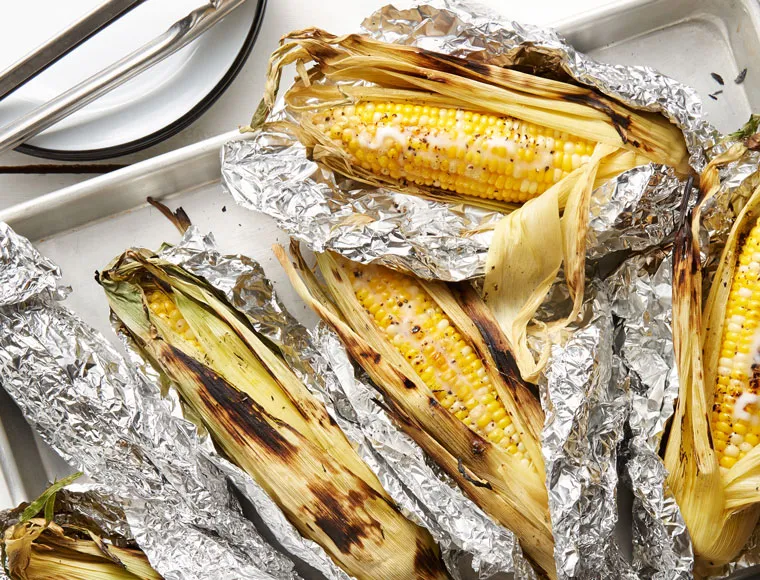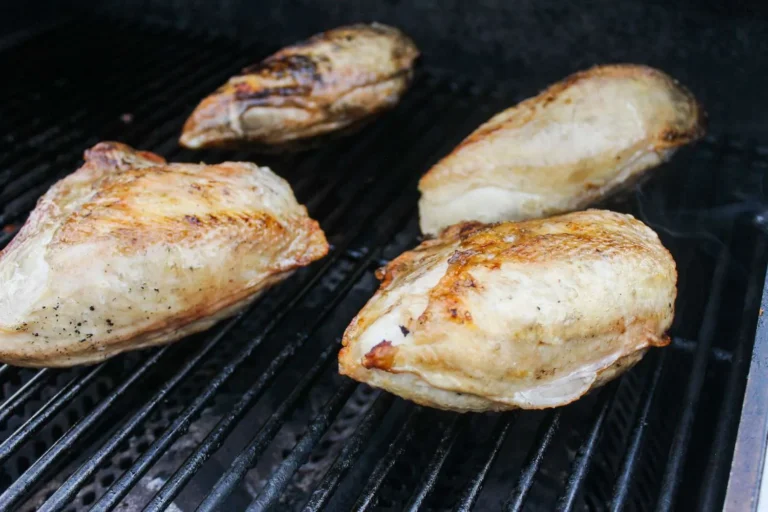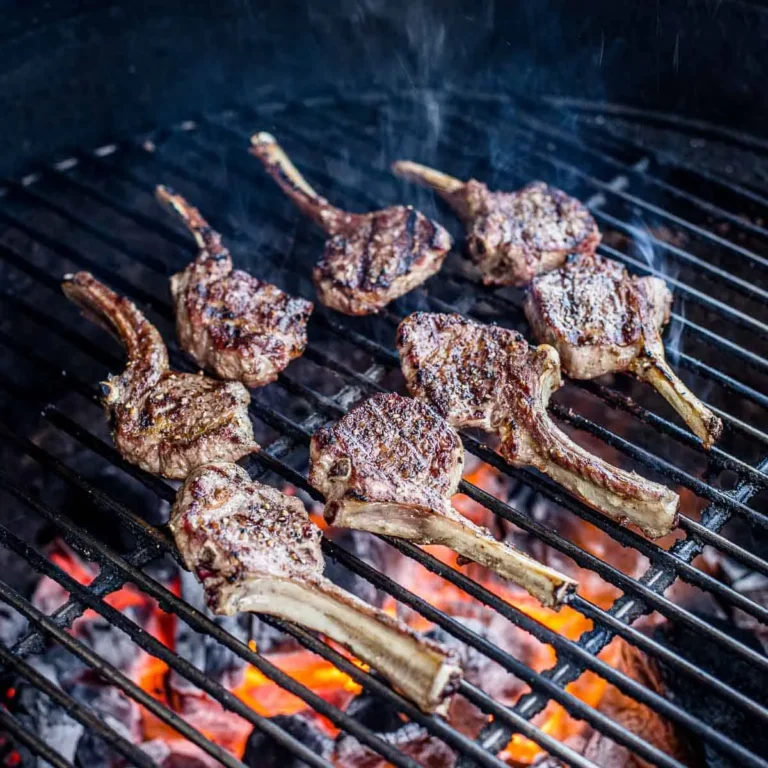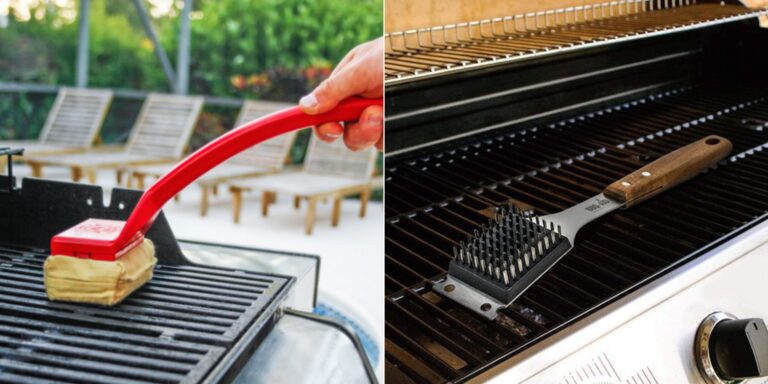How to Eat Japanese BBQ – A Yakiniku Eating Guide
When you think of barbecues, you might picture smoky grills and savory sauces. However, Japanese BBQ, particularly yakiniku, presents a unique culinary adventure. Yakiniku, translating to “grilled meat,” is a Japanese BBQ style where small pieces of meat and veggies are cooked on grids over a flame from wood charcoals that have been carbonized through dry distillation. This technique lets diners cook their food to perfection, right at their table.
In this guide, we’ll delve into the distinct features of Japanese BBQ and provide you with a thorough guide on how to eat Japanese BBQ like an expert. From grasping the essentials of the grill setup to relishing every bite, this guide will assist you in navigating the delectable realm of yakiniku. Ready to start grilling? Let’s dive in!
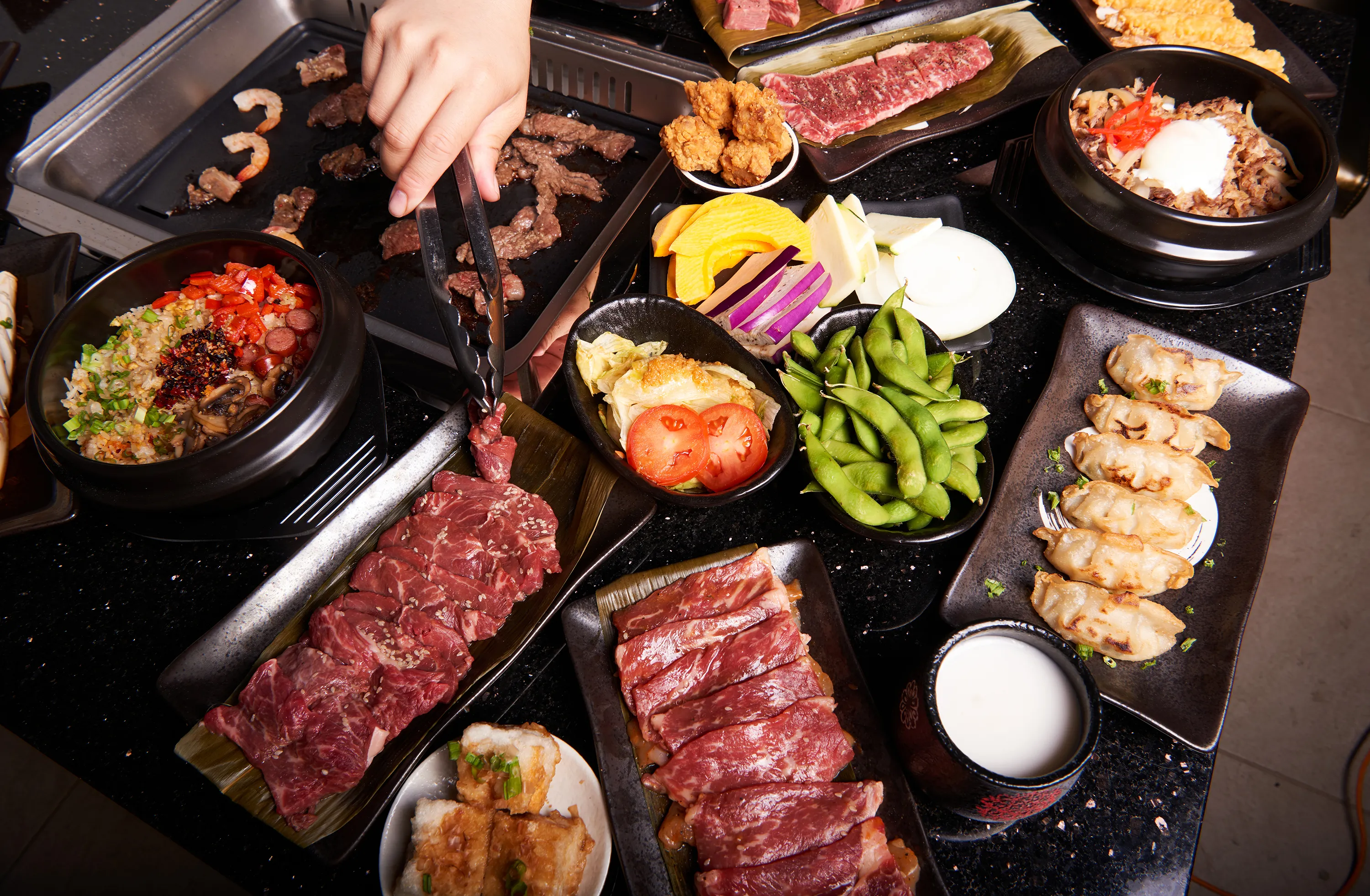
What is Yakiniku?
“Yakiniku,” meaning “grilled meat,” is a beloved Japanese BBQ style that has become an integral part of Japan’s dining tradition. Emerging in the early 1900s, yakiniku was greatly influenced by Korean BBQ but has since developed its own distinct flavors and methods.
The heart of yakiniku is the communal dining experience. Guests gather around a grill located in the middle of the table, where they cook a variety of meats, vegetables, and occasionally seafood. These ingredients are often marinated or seasoned beforehand to enhance their natural flavors.
Yakiniku is about more than just the food; it’s about the experience. The interactive element of cooking your meal at the table creates a sense of camaraderie and enjoyment. This style of dining encourages participation from everyone, making it ideal for social gatherings and family meals. With a range of dipping sauces and side dishes to accompany the grilled items, yakiniku provides a rich and diverse culinary journey that embodies the essence of Japanese BBQ.

How to Experience Yakiniku
Visiting a yakiniku restaurant for the first time can be both thrilling and slightly overwhelming. Here’s a guide to help you navigate the experience like an expert, from ordering your meal to grilling it perfectly.
When you walk into a yakiniku restaurant, you’ll typically be seated at a table equipped with a built-in grill. The atmosphere is usually vibrant, filled with the sound of sizzling meat and lively conversation, creating a cozy and inviting environment.

Ordering Your Meal
- Pick Your Cuts: The menu will offer a range of meat cuts, including beef, pork, and sometimes chicken or seafood. Common beef cuts include ribeye, short ribs, and tongue. Don’t hesitate to try different cuts to find your favorites.
- Choose Your Sides: Yakiniku often comes with a variety of sides like rice, kimchi, and assorted vegetables. These sides enhance the flavors of the grilled meat and create a balanced meal.
- Sauces and Seasonings: You’ll encounter a selection of dipping sauces such as tare (a sweet soy-based sauce), ponzu (a citrus-based sauce), and occasionally sesame oil with salt. These sauces add an extra layer of flavor to your grilled items.
Grilling Etiquette
- Grill Your Meat: Once your order arrives, use the provided tongs to place the meat on the grill. Avoid overcrowding the grill to ensure even cooking. Turn the meat with the tongs and cook it to your preferred level of doneness.
- Respect the Grill: Different items cook at varying speeds, so keep an eye on what’s on the grill. Don’t leave cooked meat on the grill for too long, as it can become overcooked and tough.
- Sharing is Caring: Yakiniku is a communal dining experience. Share the grilling duties and make sure everyone gets a fair share of the cooked items.
- Use the Dipping Sauces: Once the meat is cooked, dip it into your chosen sauce and enjoy. The combination of grilled meat and dipping sauce creates a delightful burst of flavors.
The beauty of yakiniku lies in its interactive and communal nature. Take your time, enjoy the process of grilling, and savor each bite. Engage in conversation with your dining companions and make the most of this unique culinary experience. Whether you’re a seasoned yakiniku enthusiast or a first-timer, this guide will help you enjoy Japanese BBQ to the fullest.
Ordering at a Yakiniku Restaurant
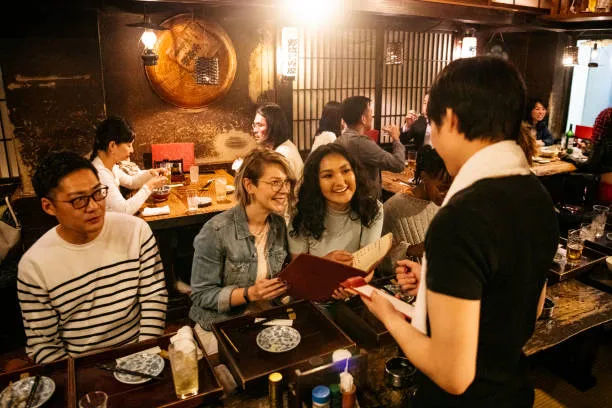
When you’re at a yakiniku restaurant, start by selecting a variety of meats. Popular options include beef cuts like ribeye, short ribs, and tongue. You can also add pork belly, chicken, or seafood for some variety. Pair your meats with sides such as rice, kimchi, and grilled vegetables. Don’t forget to choose dipping sauces like tare (sweet soy) or ponzu (citrus-based). Many menus have pictures, making it easy to point and order. If you’re uncertain, ask the server for their recommendations on the most popular or signature dishes.
Cooking Yakiniku at Your Table
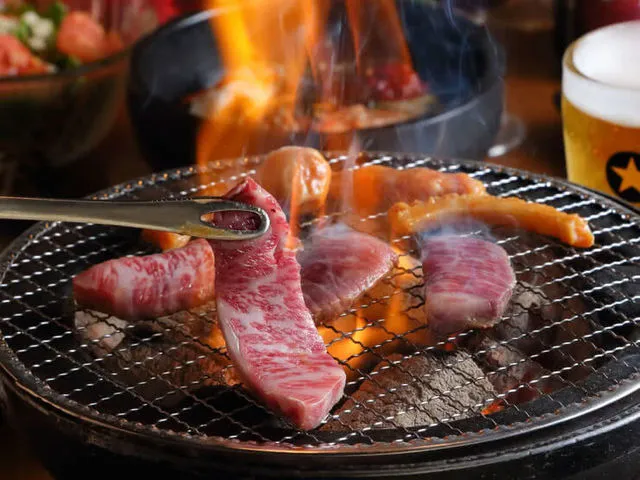
Prepare the Grill:
- Use tongs to place meats on the hot grill.
Cook Meat:
- Beef cuts: 1-2 minutes per side.
- Thicker cuts: 3-4 minutes.
- Chicken and pork: 5-7 minutes, ensure fully cooked.
Grilling Tips:
- Flip meat only once to retain juices.
- Avoid overcrowding the grill for even cooking.
Enhance Flavor:
- Use the provided dipping sauces.
- Enjoy grilled bites immediately.
If you love interactive dining, check out our guide on doing Korean BBQ at home.
Essential Yakiniku Sauces and Condiments
Yakiniku, or Japanese BBQ, is all about grilling bite-sized pieces of meat and veggies at your table. The true magic lies in the sauces and condiments that bring out the best flavors. Here’s a quick overview of the essentials you need to elevate your yakiniku game.
Yakiniku Barbecue Sauce
Yakiniku no Tare (焼肉のタレ): This is the quintessential sauce for yakiniku. It’s a perfect blend of sweet, savory, and umami flavors.
The base typically includes soy sauce, mirin, sugar, garlic, sesame seeds, and sometimes fruit juice or sake. The balance of these ingredients creates a rich, flavorful sauce perfect for dipping grilled meats.

Other Essential Sauces and Condiments
- Ponzu Sauce (ポン酢): This citrus-based sauce combines soy sauce, vinegar, and citrus juice (like yuzu or lemon). Ponzu adds a tangy, refreshing kick, making it perfect for richer cuts of meat or seafood.
- Sesame Sauce (ゴマダレ): Made from ground sesame seeds, soy sauce, sugar, and sometimes vinegar or miso. This creamy, nutty sauce pairs wonderfully with meats and vegetables, adding a rich and slightly sweet depth of flavor.
- Shio (塩): Simple yet essential, shio is just salt, often mixed with a bit of sesame oil and garlic. It’s ideal for those who prefer the natural flavors of the meat without overpowering sauces.
- Miso Sauce (味噌ダレ): Miso-based sauces can vary widely but often include mirin, sugar, and soy sauce mixed with miso paste. This gives the sauce a deep umami flavor that’s slightly sweet and salty, making it excellent for marinating or dipping.
Condiments
- Kimchi (キムチ): This spicy, fermented Korean side dish made from cabbage and radishes adds a fiery, tangy contrast to the rich flavors of grilled meat.
- Wasabi (ワサビ): Grated fresh wasabi or wasabi paste can be mixed with soy sauce for a sharp, spicy dipping sauce, especially good with beef and other red meats.
- Scallions and Garlic (ネギとニンニク): Finely chopped scallions and minced garlic can be sprinkled over grilled meats or mixed into sauces for an extra punch of flavor.
- Pickled Vegetables (漬物): Assorted pickled veggies like daikon, cucumbers, or ginger provide a refreshing, tangy counterpoint to the richness of the grilled meats.
Popular Meat Cuts for Yakiniku
When it comes to yakiniku, the choice of meat cuts can make all the difference. Here’s a rundown of the most popular cuts and some must-try options for your next yakiniku experience:

Karubi (Short Ribs):
- Description: Marbled and tender, short ribs are a favorite for their rich flavor and juicy texture.
- Must-Try: Perfect for first-timers, karubi pairs well with sweet soy-based dipping sauces.
Ribeye (Rib Roast):
- Description: Known for its balance of tenderness and flavor, ribeye is a prime choice for beef lovers.
- Must-Try: Enjoy it medium-rare for the best taste and texture.
Harami (Skirt Steak):
- Description: A leaner cut with a robust, beefy flavor. It’s slightly chewier but packed with taste.
- Must-Try: Marinated harami offers a unique taste experience, especially with a citrus-based sauce.
Gyutan (Beef Tongue):
- Description: Thinly sliced and quick to grill, beef tongue has a unique texture and is surprisingly tender.
- Must-Try: Often served with a squeeze of lemon juice to enhance its natural flavors.
Rosu (Sirloin):
- Description: A lean and tender cut, sirloin is perfect for those who prefer a less fatty option.
- Must-Try: Best enjoyed with minimal seasoning to appreciate its natural beefy flavor.
Tontoro (Pork Neck):
- Description: Fatty and flavorful, pork neck is a succulent choice that melts in your mouth.
- Must-Try: Ideal for grilling until crispy on the edges for a delightful texture contrast.
Chicken Thigh:
- Description: Juicy and flavorful, chicken thighs are a versatile option that absorbs marinades well.
- Must-Try: Marinate in a savory sauce and grill until tender for a delicious bite.
Side Dishes and Accompaniments
To enhance your yakiniku experience, a variety of side dishes and accompaniments are served to complement the grilled meats. Here are some typical options you’ll find:

Kimchi:
- Description: Spicy and tangy fermented vegetables, usually cabbage, that add a refreshing contrast to the rich flavors of grilled meat.
- Why It’s Great: The acidity and spice help cleanse your palate between bites of meat.
Rice:
- Description: Steamed white rice is a staple that pairs perfectly with grilled meats, absorbing the delicious juices and sauces.
- Why It’s Great: It provides a neutral base that balances the flavors of the meal.
Namul:
- Description: A variety of seasoned vegetable side dishes, including spinach, bean sprouts, and other greens.
- Why It’s Great: These healthy sides offer a mix of textures and flavors that complement the grilled meat.
Salad:
- Description: Fresh, crisp salads often dressed with a light vinaigrette or sesame dressing.
- Why It’s Great: The freshness and crunch of the salad provide a nice contrast to the richness of the meat.
Miso Soup:
- Description: A traditional Japanese soup made with miso paste, tofu, seaweed, and green onions.
- Why It’s Great: It’s a warm and comforting side that adds depth to the meal.
Pickled Vegetables (Tsukemono):
- Description: Various pickled vegetables, such as cucumbers, daikon radish, and carrots.
- Why It’s Great: The sharp, tangy flavors of the pickles enhance the taste of the grilled meats.
Korean Pancakes (Pajeon):
- Description: Savory pancakes made with green onions and often mixed with seafood or vegetables.
- Why It’s Great: These crispy pancakes are a delightful accompaniment to the meats, adding a different texture and flavor.
Garlic Chips:
- Description: Thinly sliced and fried garlic chips that add a crunchy and aromatic element.
- Why It’s Great: They provide a burst of flavor that complements the savory taste of the meat.
Grilled Vegetables:
- Description: Assorted vegetables like bell peppers, mushrooms, onions, and zucchini, grilled alongside the meats.
- Why It’s Great: They add variety and a healthy component to the meal, balancing out the meat-heavy dishes.
These side dishes not only enhance the flavors of the grilled meats but also provide a balanced and satisfying dining experience. Enjoy the interplay of textures and tastes as you savor each bite of your yakiniku feast.
Top Yakiniku Restaurants in Japan
If you’re aiming to savor the finest yakiniku in Japan, here’s a curated list of top restaurants across the country, each offering a unique take on this beloved Japanese barbecue style.
Gazan Garden (Kamiyacho)
- Location: Kamiyacho, Tokyo
- Features and Popular Dishes: Gazan Garden is known for its elegant, modern ambiance that provides a refined dining experience. The restaurant boasts a wide selection of premium beef cuts, including A5 Wagyu and meticulously sourced local meats. A standout dish is the Special Wagyu Platter, which lets diners enjoy different cuts of top-quality Wagyu beef. With a focus on detail in presentation and high-quality ingredients, Gazan Garden is a favorite among yakiniku enthusiasts.
Yakiniku Okuu Shinbashi Branch
- Location: Shinbashi, Tokyo
- Ambiance and Specialty Dishes: Yakiniku Okuu’s Shinbashi location is celebrated for its cozy, intimate setting, ideal for casual dining and special occasions alike. The restaurant takes pride in its Kuroge Wagyu offerings, featuring melt-in-your-mouth beef cuts that are a must-try. The Beef Tongue is particularly popular for its tender texture and rich flavor. Excellent service combined with top-notch meat quality makes Yakiniku Okuu a standout in Shinbashi.
Rokkasen (Shinjuku)
- Location: Shinjuku, Tokyo
- Overview and Must-Visit Factors: Located in the bustling district of Shinjuku, Rokkasen is a go-to spot for yakiniku lovers. The restaurant is famous for its all-you-can-eat (tabehoudai) options, allowing diners to indulge in an unlimited feast of high-grade meats. Rokkasen’s menu features a variety of cuts, including premium Wagyu and seafood options. The lively atmosphere and extensive menu make it a top choice for a comprehensive yakiniku experience in Tokyo.
NIKUSHO Nakata (Omote-sando)
- Location: Omote-sando, Tokyo
- Approach and Standout Features: NIKUSHO Nakata takes a refined approach to yakiniku, emphasizing the art of grilling and the quality of its meat selections. Situated in the chic Omote-sando area, the restaurant offers an upscale yet welcoming environment. A highlight is the Chef’s Selection Platter, showcasing the best cuts of the day, meticulously prepared and presented. The use of high-grade Wagyu and attention to culinary details make NIKUSHO Nakata a premier destination for yakiniku connoisseurs.
These top yakiniku restaurants in Japan not only offer exceptional food but also unique dining experiences, making them must-visit spots for anyone looking to explore the rich world of Japanese barbecue.
Comparing Japanese BBQ with Other Styles
Japanese BBQ, particularly yakiniku, offers a distinct experience compared to other international BBQ styles. Let’s dive into a comparative analysis to highlight the differences in cooking techniques and flavors.
Japanese BBQ (Yakiniku)
- Cooking Techniques: In yakiniku, small, bite-sized pieces of meat and vegetables are grilled over a direct flame, typically at the table. The grill is often a gridiron over wood charcoals, allowing diners to cook their food to their liking. This interactive and communal method sets it apart from many other BBQ styles.
- Flavors: The focus is on the natural flavors of the meat, often enhanced with minimal seasonings or marinades. Dipping sauces like tare (sweet soy) and ponzu (citrus-based) are served on the side, allowing for personalized flavor adjustments.
American BBQ
- Cooking Techniques: American BBQ is characterized by slow-cooking large cuts of meat over indirect heat, often in a smoker. Techniques like smoking and grilling are common, with an emphasis on achieving a smoky flavor and tender texture.
- Flavors: Bold, robust flavors are key, with meats marinated or dry-rubbed with spices and herbs. BBQ sauces, often sweet and tangy, are used both during the cooking process and as a finishing touch.
Korean BBQ
- Cooking Techniques: Similar to Japanese yakiniku, Korean BBQ involves grilling meat at the table, often with more elaborate marinades and side dishes. The grill is usually integrated into the table, and diners cook a variety of meats and vegetables.
- Flavors: Korean BBQ flavors are rich and varied, with meats marinated in mixtures of soy sauce, garlic, sesame oil, and sugar. The cuisine also includes a wide array of banchan (side dishes) like kimchi, pickled vegetables, and rice.
Brazilian BBQ (Churrasco)
- Cooking Techniques: Brazilian BBQ, or churrasco, involves grilling large cuts of meat on skewers over an open flame. The meat is often seasoned simply with salt and cooked by rotating the skewers to ensure even cooking.
- Flavors: The emphasis is on the quality and natural taste of the meat. Meats are typically seasoned lightly, allowing the flavor of the beef, pork, or chicken to shine. Accompaniments often include chimichurri sauce and farofa (toasted cassava flour).
Argentine BBQ (Asado)
- Cooking Techniques: Asado is a traditional Argentine method where meats are grilled on a parrilla (grill) or cooked over an open flame. The cooking process is slow and meticulous, aiming to infuse the meat with smoky flavors.
- Flavors: Simplicity is key in asado, with meats typically seasoned with coarse salt. The focus is on the natural flavor of high-quality cuts, often accompanied by chimichurri sauce and grilled vegetables.
Key Differences
- Interaction: Japanese and Korean BBQ emphasize interactive dining with grilling at the table, fostering a communal experience.
- Flavor Profiles: Japanese BBQ highlights the natural flavors with minimal seasoning, while American BBQ is known for bold, smoky, and saucy flavors. Korean BBQ uses rich marinades, whereas Brazilian and Argentine BBQs focus on the pure taste of the meat with simple seasonings.
- Cooking Techniques: The slow, indirect heat of American, Brazilian, and Argentine BBQs contrasts with the quick, direct grilling methods of Japanese and Korean BBQs.
How to Set Up a Yakiniku Grill at Home
Creating an authentic yakiniku experience at home can be a fun and rewarding way to enjoy this Japanese BBQ style. Here’s a step-by-step guide to help you set up your own yakiniku grill at home, complete with equipment and ingredient suggestions.
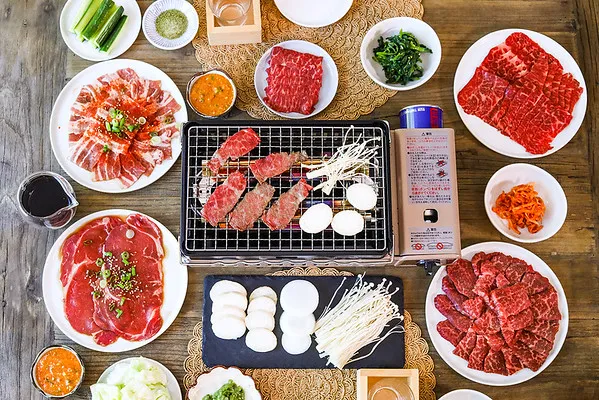
Equipment Needed
Tabletop Grill:
- Types: Charcoal grill for an authentic experience or an electric grill for convenience.
- Suggestions: Portable tabletop charcoal grills or electric grills with adjustable heat settings.
Grill Net or Plate:
- Material: Stainless steel or cast iron.
- Features: Ensure it’s easy to clean and fits your grill.
Tongs and Cooking Utensils:
- Types: Long tongs for handling meat and vegetables.
- Suggestions: Stainless steel tongs and a spatula for flipping and serving.
Plates and Serving Dishes:
- Variety: Small plates for dipping sauces and larger plates for meats and vegetables.
- Suggestions: Traditional Japanese-style plates can enhance the experience.
Dipping Sauce Bowls:
- Types: Small, individual bowls.
- Suggestions: Ceramic or porcelain bowls for a traditional touch.
Ingredients
Meat Selections:
- Beef: Ribeye, short ribs (karubi), skirt steak (harami), and beef tongue (gyutan).
- Pork: Pork belly (tontoro) and pork neck.
- Chicken: Chicken thigh.
- Seafood: Shrimp, scallops, and squid for variety.
Vegetables:
- Options: Bell peppers, mushrooms, zucchini, onions, and eggplant.
- Preparation: Cut into bite-sized pieces for easy grilling.
Dipping Sauces:
- Tare: Sweet soy-based sauce.
- Ponzu: Citrus-based sauce.
- Sesame Oil with Salt: For a simple, flavorful dip.
Side Dishes:
- Rice: Steamed white rice.
- Kimchi: Spicy fermented cabbage.
- Namul: Seasoned vegetable dishes like spinach and bean sprouts.
- Pickled Vegetables: Tsukemono, such as pickled cucumbers and daikon radish.
Setting Up
Prepare the Grill:
- If using a charcoal grill, light the charcoal and allow it to heat until the coals are glowing red.
- For electric grills, preheat to the desired temperature, typically medium-high.
Arrange Ingredients:
- Place meats and vegetables on large serving plates.
- Set up dipping sauces in small bowls for each guest.
Grilling Station:
- Set the grill in the center of the table for easy access.
- Provide each guest with tongs and small plates for their grilled items.
Cooking Tips:
- Grill meats in small batches to ensure even cooking.
- Cook beef cuts for 1-2 minutes per side, thicker cuts for 3-4 minutes.
- Ensure chicken and pork are fully cooked, usually 5-7 minutes.
- Flip meats only once to retain juices and flavor.
Serving and Enjoying:
- Encourage guests to dip their grilled meats in the provided sauces.
- Enjoy the meal at a leisurely pace, savoring each bite and the communal grilling experience.
Techniques and Etiquette on How to Eat Japanese BBQ
- Grill Control: Keep the heat on medium-high for meats and lower for veggies. Too hot, and you’ll burn everything.
- Slice it Right: Thin slices cook faster and more evenly. Plus, they soak up marinades better.
- Don’t Overcrowd: Give each piece space to cook evenly. Crowded grills lead to uneven cooking.
- Use Tongs: Always use tongs to handle raw meat. It’s more hygienic and respectful.
- Take Turns: Share the grilling duties. Everyone should get a chance to cook and enjoy.
- Eat in Order: Start with lighter meats and veggies, then move to heavier cuts. This enhances the flavor experience.
FAQs about Yakiniku
Disclosure: Our blog contains affiliate links to products. We may receive a commission for purchases made through these links. However, this does not impact our reviews and comparisons. We try our best to keep things fair and balanced, in order to help you make the best choice for you.


